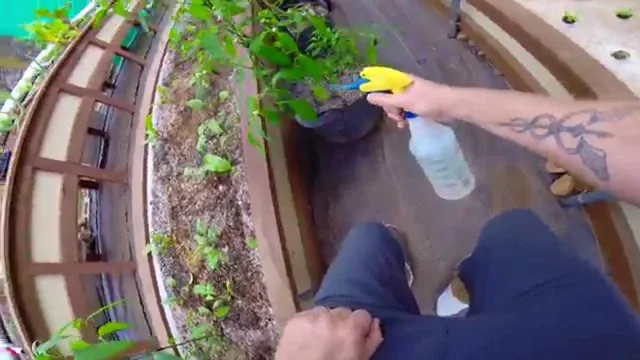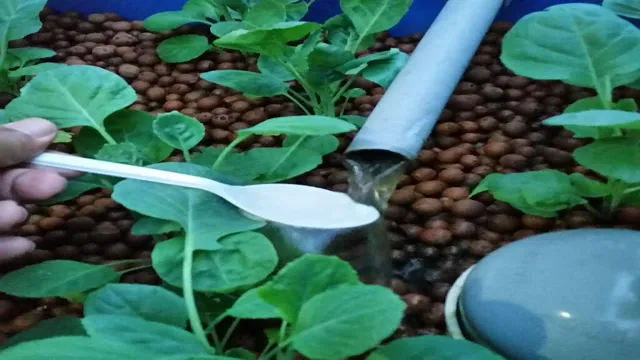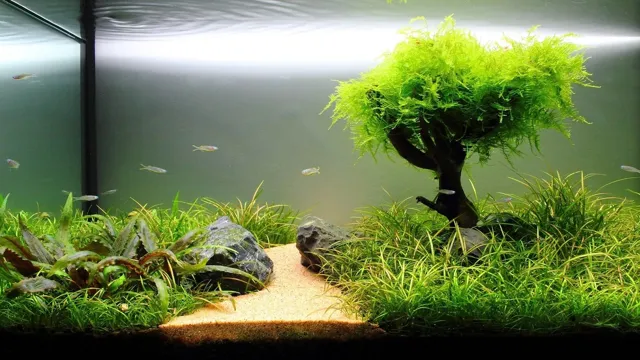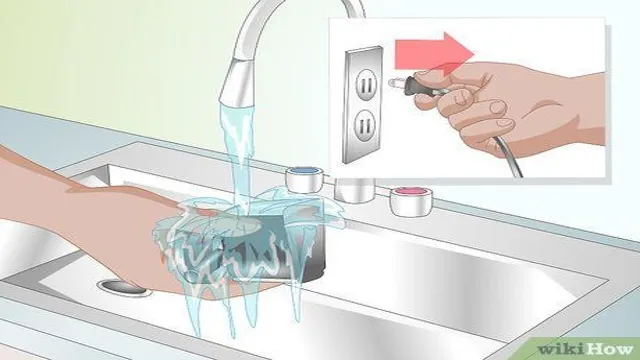Do you feel like your aquarium plants are lacking in health and vibrancy? One method to boost their growth and appearance is to add magnesium to their nutrient intake. Magnesium is an essential element that plays a crucial role in photosynthesis, which is the process by which plants convert light energy into chemical energy. Magnesium deficiency in plants can manifest in various ways, such as stunted growth, yellowing leaves, and weak stems.
Thus, adding magnesium can be a simple yet effective way to promote the overall health and longevity of your aquarium plants. Plus, it can enhance their coloration, making them stand out in your tank. But how do you add magnesium to your aquarium plants? One option is to use a fertilizer that contains magnesium, such as those specifically designed for aquariums.
Alternatively, you can add Epsom salt, a magnesium sulfate compound, directly to your aquarium water. However, it’s crucial to dose properly as too much magnesium can cause harm to your aquatic inhabitants. Adding magnesium to your aquarium plants is a relatively easy way to improve their health and appearance.
By ensuring they receive their necessary nutrients, you can create a thriving and beautiful underwater ecosystem. So go ahead and give your plants the magnesium boost they need to flourish!
Understanding Magnesium in Aquariums
If you’re an aquarium enthusiast, then you probably know that magnesium is an essential element for maintaining a healthy aquatic environment. Magnesium is particularly important for aquarium plants as it helps them to grow and thrive. It is found naturally in many aquarium substrates, but in some cases, it may be necessary to supplement magnesium levels in the water.
To add magnesium to aquarium plants, you can use commercially available magnesium supplements, such as magnesium sulfate or magnesium chloride. These supplements are added to the aquarium water in small amounts and can be easily absorbed by plants. It’s important to note that excessive magnesium levels can be harmful to fish, so it’s crucial to use the supplements sparingly and monitor the magnesium levels in the water regularly.
With the right care and attention, you can ensure that your aquarium plants receive the magnesium they need to grow strong and healthy.
The role of magnesium in plant growth
Magnesium plays a crucial role in plant growth. It is an essential micronutrient required by all plants for photosynthesis. In aquariums, understanding magnesium is essential to maintaining healthy aquatic plants.
Magnesium is often found in tap water, but the levels can be insufficient for plants to thrive. Therefore, the addition of magnesium supplements is necessary to fulfill the plant’s magnesium requirements. Magnesium supplements can be added in the form of magnesium sulfate, which is readily available in aquarium stores.
By ensuring the proper levels of magnesium, one can promote healthy and vibrant aquatic plant growth. Remember, just like humans, plants need a balanced diet to thrive, and magnesium is a vital component of that diet.

Testing magnesium levels in the aquarium
Magnesium in Aquariums Aquarium enthusiasts often overlook the importance of magnesium in their tanks. Magnesium plays a crucial role in maintaining a healthy and balanced aquarium environment. It helps in the growth of invertebrates, coral, and even marine plants.
Additionally, magnesium helps regulate pH levels and prevent the accumulation of calcium and other minerals that may lead to harmful water conditions. Therefore, it is essential to understand the magnesium levels in your aquarium through regular testing. Testing kits are readily available, and it is a straightforward process that involves measuring the magnesium level in parts per million (ppm).
Keeping the magnesium levels stable between 1200-1400 ppm will ultimately promote the overall wellbeing of your tank inhabitants, keeping them healthy and thriving. Maintaining the ideal magnesium level requires diligence, but the benefits for your aquarium are truly worth it. (See Also: How to Make an Aquarium Tree at Home: A Step-by-Step Guide)
Sources of Magnesium for Aquarium Plants
If you’re growing aquatic plants in your aquarium, you’ll want to make sure they’re getting all the nutrients they need to thrive. Magnesium is one such nutrient that plays a crucial role in plant growth and development. Adding magnesium to your aquarium is easier than you might think.
One option is to use a magnesium supplement specifically formulated for aquarium plants. Another option is to add Epsom salt (magnesium sulfate) to your aquarium water. Simply dissolve a small amount of Epsom salt in water and add it to your tank.
Keep in mind that while magnesium is important for your plants, too much can be harmful to your fish. Be sure to follow dosage instructions carefully and monitor your water chemistry regularly. With just a little bit of extra care, you can ensure your aquarium plants are getting all the magnesium they need to thrive.
Using Magnesium supplements
Magnesium supplements Aquarium plants require a variety of nutrients to grow healthy and strong, and magnesium is one of them. Magnesium plays a crucial role in photosynthesis, the process by which plants convert sunlight into energy. Without enough magnesium, aquarium plants may suffer from stunted growth, yellowing leaves, and even death.
Thankfully, there are several sources of magnesium that you can provide to your aquatic flora. One of the easiest and most effective ways is to use magnesium supplements specifically designed for aquarium use. These supplements typically come in the form of liquids or powders that you can add directly to your aquarium water.
Another option is to use natural sources of magnesium such as dolomite or Epsom salt, which can be added to the substrate or water. Regardless of the source you choose, it’s important to monitor your aquarium’s magnesium levels regularly using a test kit to ensure that your plants have everything they need to thrive.
Using Epsom Salt
If you’re looking for a good source of magnesium for your aquarium plants, then Epsom salt could be just what you need. Not only is it affordable and readily available, but it’s also easy to use and can provide the necessary nutrients to keep your plants healthy and vibrant. Epsom salt is essentially magnesium sulfate, and when added to your aquarium water, it can be absorbed by your plants’ roots.
This nutrient will help your plants produce chlorophyll, which is essential for photosynthesis and overall growth. And unlike some other sources of magnesium, like limestone or dolomite, Epsom salt won’t raise the pH of your aquarium water or cause any other adverse effects. So whether you’re a seasoned aquarium enthusiast or a beginner, consider using Epsom salt as an excellent source of magnesium for your aquarium plants!
Using Dolomite or Limestone
Magnesium for Aquarium Plants: Using Dolomite or Limestone If you’re looking for a natural source of magnesium for your aquarium plants, dolomite or limestone are great options to consider. Both of these rocks contain high levels of magnesium carbonate that can help support plant growth and overall aquarium health. Dolomite is a sedimentary rock that is typically white or gray in color and is composed mainly of calcium magnesium carbonate.
Adding dolomite to your aquarium can help stabilize pH levels and provide essential nutrients for plant growth. Dolomite can also promote the growth of healthy bacteria that can help remove harmful toxins from the water. Limestone is another rock that can be used to increase magnesium levels in your aquarium.
Limestone contains calcium carbonate and magnesium carbonate, which can provide essential nutrients for plant growth. Limestone can also help maintain pH levels and reduce the acidity of the water. When adding dolomite or limestone to your aquarium, it’s important to start with small amounts and monitor the pH levels closely.
A sudden increase in pH can be harmful to your fish and other aquatic life. It’s also important to avoid adding too much at once, as this can lead to excessive algae growth. In conclusion, using dolomite or limestone can be an effective way to provide your aquarium plants with the magnesium they need to thrive. (See Also: How to Change Aquarium Light Bulb in 5 Easy Steps – Ultimate Guide)
However, it’s important to use caution and start with small amounts to ensure the health of your aquarium ecosystem.
How to Add Magnesium to Aquarium Plants
If you are struggling with yellow leaves or stunted growth in your aquarium plants, it might be a sign of magnesium deficiency. Magnesium is an essential nutrient that is often overlooked, but it plays a critical role in plant growth and development. Luckily, there are several ways to add magnesium to your aquarium plants.
One easy way is to use aquarium fertilizers that contain magnesium. Most commercially available fertilizers have a balanced mix of macro and micronutrients, and adding a little extra can help boost magnesium levels. Another option is to add Epsom salt directly into the water.
Epsom salt is a form of magnesium sulfate that dissolves easily in water. Just be sure to slowly add it over time, so you don’t shock the plants or fish. Finally, consider using magnesium-rich substrates such as dolomite or aragonite.
These substrates release magnesium slowly over time, providing a continuous source of this essential nutrient. By adding magnesium to your aquarium plants, you can ensure healthy growth and vibrant coloration.
Dosing Magnesium supplements
When it comes to adding magnesium to your aquarium plants, there are a few things to keep in mind. First and foremost, it’s important to choose the right supplement for your tank. Magnesium supplements come in different forms, including powders, liquids, and tablets.
You should also consider the dosing requirements for your specific plants. Magnesium is a crucial nutrient for healthy plant growth, and it’s essential for photosynthesis and the production of chlorophyll. However, it’s possible to overdo it with magnesium, so be sure to follow the recommended dosage guidelines carefully.
Keep an eye on your plant’s growth and health to ensure that everything is on track. With the right supplement and proper dosing, adding magnesium to your aquarium plants can result in vibrant, healthy foliage that will enhance the beauty of your tank.
Dosing Epsom Salt
Dosing Epsom Salt can be a great way to add essential Magnesium to aquarium plants. Magnesium is a vital nutrient that helps plants grow and develop properly, and it can be easy for aquarium plants to become deficient in this nutrient without proper supplementation. Adding Epsom Salt to your aquarium is a simple and effective way to ensure your plants have enough Magnesium.
To add Epsom Salt, first, determine how much your aquarium needs based on the size of your tank and the level of Magnesium deficiency. Then dissolve the Epsom Salt in a separate container of water before adding it to the tank. It’s recommended to add the Epsom Salt slowly over a period of time to avoid shocking the plants or causing an imbalance in the tank.
With regular Epsom Salt dosing, your aquarium plants will thrive and stay healthy. So, add Epsom Salt to your aquarium, and you’ll notice a significant improvement in the growth and overall appearance of your plants. (See Also: How to Catch Long Spine Urchin from Aquarium: Tips and Tricks)
Conclusion
In conclusion, adding magnesium to aquarium plants is essential for their health and growth. But let’s be real, introducing magnesium into your aquatic ecosystem isn’t exactly rocket science. Just follow these simple steps: test your water regularly, identify any magnesium deficiencies, choose the right magnesium supplement, and add it in small doses over time.
With a little patience and a keen eye, your plants will be thriving in no time! And who knows, maybe you’ll even become a “mag-nes-“sia expert. Alright, we’ll see ourselves out now.”
FAQs
What are the benefits of adding magnesium to aquarium plants?
Magnesium is essential for healthy growth and development of aquarium plants. It helps in the production of chlorophyll, which is necessary for photosynthesis, and also aids in the absorption of other important nutrients like calcium and potassium.
How do I know if my aquarium plants are deficient in magnesium?
If your aquarium plants are showing signs of slow growth, yellowing leaves or stunted development, it may be an indication of magnesium deficiency. You can also conduct a water test to check the magnesium levels in your aquarium.
What is the best way to add magnesium to aquarium plants?
The most common way to add magnesium to aquarium plants is by adding a magnesium supplement to the water. You can choose from a variety of commercially available supplements or opt for natural sources like Epsom salt or dolomite lime.
Can I overdose on magnesium when adding it to my aquarium plants?
Yes, it is possible to overdose on magnesium, which can lead to toxicity in your aquarium. It is important to follow the recommended dosage on the supplement package or consult with a professional aquarist if you are unsure.
How often should I add magnesium to my aquarium plants?
The frequency of adding magnesium to your aquarium plants will depend on the specific needs of your plants and the magnesium levels in your water. As a general rule, adding magnesium once a week is a good starting point, but it’s always best to monitor your plants and adjust as necessary.
Can magnesium supplementation benefit other aquatic creatures in my aquarium?
Yes, magnesium supplementation can benefit other aquatic creatures in your aquarium, including fish, invertebrates and other plants. Just be sure to monitor the magnesium levels and adjust accordingly as each species has specific needs.
Are there any alternatives to adding magnesium for aquarium plant health?
While magnesium is an important nutrient for aquarium plants, there are other ways to promote healthy growth and development. These include providing adequate lighting, CO2 supplementation, and ensuring proper nutrient balance in the water.







